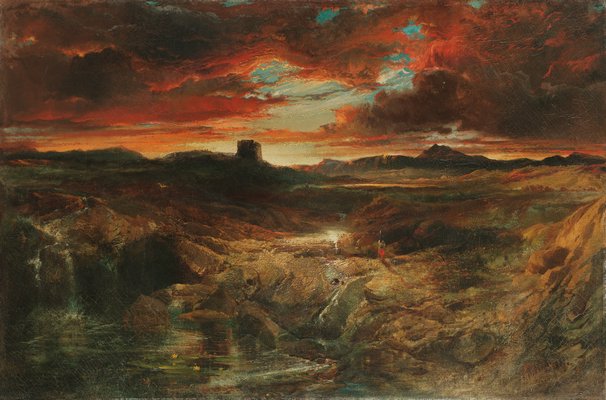
Ambitiously early into his career, Thomas Moran had a mission. He would be one of the greatest American artists who ever lived—if not the best.
He did all the right things. He exhibited in galleries for nearly 60 years, from 1859 to 1917. He designed and built his own home-studio in East Hampton, which was a trend among successful artists of the time. And, most importantly, he painted what America loved.
Collectors wanted nationalism. They wanted poetry. They wanted mythology. They wanted nostalgia. And Moran had no problem giving them exactly that.
Yet, he rarely makes it into the history books today, according to expert Phyllis Braff, who is guest curating “Tracing Moran’s Romanticism & Symbolism” at Guild Hall in East Hampton—a 20-piece, collection-in-context exhibition opening Saturday, October 26, that is the first of its kind.
“He didn’t really start a new movement,” Ms. Braff said of the artist last week during a telephone interview. “He didn’t contribute to anything innovative that, then, had followers. He more digested the great trends of Europe. He loved the old masters and their techniques, and he applied them to what he thought was the grander subject matter, which was American scenery.”
The English-born painter grew up just outside of Philadelphia, Pennsylvania, where he began his career as a teenage apprentice for Scattergood & Telfer, a wood-engraving firm. He found the apprentice work tedious, but by the mid-1850s, he was drawing the firm’s illustrations rather than carving them.
He began studying with local painter James Hamilton, who introduced him to the work of British artist J.M.W. Turner—who was then considered the world’s greatest romantic painter. Turner immediately influenced Moran’s own use of color and choice of landscapes, Ms. Braff said. In 1862, the burgeoning artist traveled back to England to see Turner’s work and, that same year, replicated Turner’s famous “Ulysses Deriding Polyphemus”—which will be included in the exhibit—derived from Homer’s epic poem “The Odyssey.”
In the years that followed, Moran explored Civil War sentiments with his 1864 painting, “Nutting,” depicting a family in the woods gathering nuts—a traditional activity and a return to normalcy that Americans craved, Ms. Braff explained of yet another piece to be included in the exhibit. The piece was created specifically for the Philadelphia Sanitary Fair, a fundraiser for the wounded that President Abraham Lincoln attended, she said.
The artist also documented what is now Yellowstone National Park—feeding off a national pride for western expansionism—during a 40-day trip alongside photographer William Henry Jackson that captured America’s attention and helped inspire Congress to establish the region as the first national park in 1872. He revisited the topic in 1917 with his work “Above Tower Falls,” which will also be on view at Guild Hall, that appeals to the wonders of American geology.
“He’s important as a barometer of public taste,” Ms. Braff said. “His work seems to correspond with public taste and there are phases in his career where he adjusted and was always representing public sentiments. And we see how it comes out in Moran’s eye. He focused on the internal emotions generated by a scene. That was the most important thing to get down on canvas.”
By the 1870s, the curiosity surrounding the unexplored West had shifted to an emphasis on pastoral, unspoiled, anti-industrial countryside—found in abundance on the East End, Moran soon learned from his artist friends. Following an unexpectedly successful series of exhibits in England, Moran came back to the United States in 1882 with a great deal of wealth and moved to East Hampton, where he eventually designed and built his home and studio overlooking Town Pond.
And over his mantel hung the 7-foot-wide “Ulysses Deriding Polyphemus.”
“Moran was so attached to this major copy that he made of his great inspiration that he kept this painting with him always,” Ms. Braff said. “He was never a plein air painter. He never painted out of doors. ‘That was silly. You couldn’t do a picture that way.’ It was a studio endeavor.”
He believed in painting the sensation and the emotion of a scene, she reported, not its exact details. After visiting the beaches or countryscapes of East Hampton, Moran would return to his double-height, wood-paneled studio and think about what he had seen.
Then, he would lay the scene in tones of charcoal, building up the shadows and highlights, Ms. Braff said, followed by under-paintings and various layers of tonal glazes—famously seen in “The Much Resounding Sea,” which hangs in the National Gallery of Art in Washington, D.C. For the first time since its completion in 1884, the 6-foot-wide piece is returning home—temporarily.
“This is a really, really big deal,” Ms. Braff said of its inclusion in the show. “It’s coming by courier and people meeting the plane and all of that. It’s a great treasure.”
In 1926, Moran died at age 89 of natural causes in Santa Barbara, California, where he lived the last of his days. Nearly 40 years later, his East Hampton home and studio were named a National Historic Landmark in 1965.
“It’s exactly as it was,” Ms. Braff said. “Above the wood paneling, there’s some beautiful Victorian wallpaper. It still has gold flecks in it. And when the sun hits it just right, it looks like shiny gold. Beautiful.”
This piece of Thomas Moran lives on, she said. Outside of the history books.
“Tracing Moran’s Romanticism & Symbolism” will open with a reception on Saturday, October 26, from 5 to 7 p.m. at Guild Hall in East Hampton. The exhibit will remain on view through January 5. For more information, call 324-0806 or visit guildhall.org.